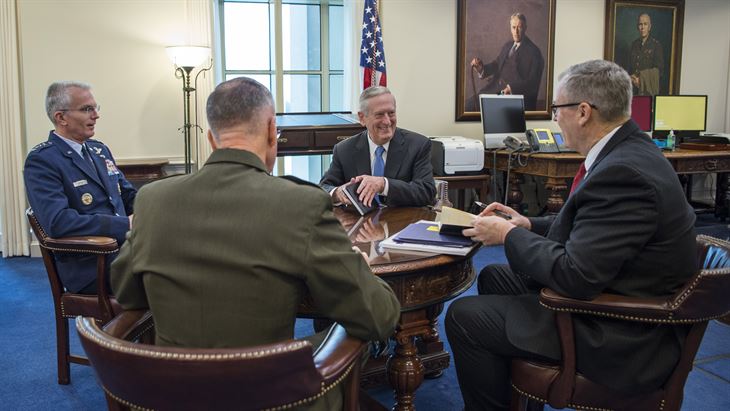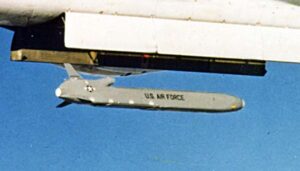Why Mattis Should Support Long Range Stand-Off Nuclear Cruise Missile
Posted on

James Mattis, Defense Secretary
During his Senate confirmation hearing, Defense Secretary James Mattis expressed doubts over plans to buy the nuclear Long Range Stand-Off cruise missile (LRSO).
“I need to look at that one.” Mattis said, “My going in position is that it makes sense, but I have to look at it in terms of its deterrence capability.”
While Mattis should take a careful look at LRSO, or any major weapons program, his initial instinct—that LRSO makes sense—is correct. Let me explain.
In an air environment that is becoming increasingly deadly because of Russian advances in integrated air defenses, it is growing increasingly difficult, even for the B-2 and B-21 stealth bombers, to directly strike hardened and deeply buried targets with the B-61 mod 12 nuclear gravity bomb. While these aircraft will be the most advanced bombers in the world over the next three decades, it will become increasingly difficult to defeat the layered IADS they are certain to face as they attempt to reach very specific types of targets.

B-21
With the US Air Force planning to field between 100 and 120 nuclear capable stealth bombers (B-2/B-21) over the next three decades, the fleet may very well be too small to hold all required targets at risk. In other words, the notion that any nuclear delivery system is “redundant” is incorrect and fails to account for the fact that getting a weapon to its designated target is far harder than many often understand.
The fact is, stealth aircraft are neither invisible nor invincible. Both the B-2 and B-21 achieve survivability by producing a reduced radar cross section—directing radar returns in predictable directions away from the receiver. This predictability allows for mission planning against known IADS locations. However, against mobile threats, whose location are unknown, radar returns could give away the position of a stealth aircraft. This risk increases when the density of an IADS network increases, which is likely around the high value targets such aircraft may target.
Some will argue that any target a B-2 or B-21 cannot hit can be struck by an Intercontinental Ballistic Missile (ICBM) or Submarine Launched Ballistic Missile (SLBM). This is simply not true. Our adversaries have watched both ICBM and SLBM test shots for decades and have a firm understanding of the flight physics of our weapons, so they know how to position and build facilities that cannot be destroyed by ballistic missiles. The adage that nuclear weapons are like horse shoes and hand grenades — close is good enough —simply is not true for every target.

Air-Launched Cruise Missile (ALCM)
In short, some well-placed and defended targets are unavailable to stealth aircraft. This means a stealthy cruise missile, which is only a fraction of the size of a stealth bomber, has a much greater probability of arrival at the designated target. And given that there are targets which neither a SLBM nor (ICBM) can hit — largely because their reentry angle will not allow it — LRSO is critical.
Nuclear cruise missiles also have the strategic benefit of requiring far less logistical and planning support and can fly profiles against difficult targets that no bomber can fly. With standoff weapons, the planner’s main concern once the weapon is launched is reaching the target. If a bomber is required to drop a B-61 inside the target country, planning becomes significantly more complicated—along with the added risk to the aircraft and crew. This is because a great deal of additional planning and support (suppression of enemy air defense) is required to ensure the bomber has the greatest probability of reaching the target and then returning from the mission.
Should a cruise missile be lost to enemy IADS, the loss is considerably less than if our small bomber fleet is lost over enemy territory. It is worth noting that after a US nuclear strike on an enemy target, the United States will seek to reestablish deterrence, which will require American bombers regenerate and be ready to fly the next strike mission. If they are lost to enemy IADS, this cannot happen.
When it comes to replacing the ALCM with LRSO, the need is clear. A new stealthy nuclear cruise missile that has a much improved probability of striking and destroying a critical target will give any adversary ample reason to reconsider provocative actions that may lead the United States to use its nuclear weapons. Increasing an adversary’s perceived risk is a good thing. Too often our adversaries question American resolve and mistake our compassion for weakness. As former Secretary of Defense Donald Rumsfeld once said: “Weakness is provocative.”
Subscribe to our newsletter
Promotions, new products and sales. Directly to your inbox.
